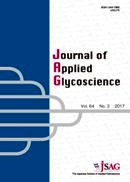
- 4 号 p. 81-
- 3 号 p. 59-
- 2 号 p. 43-
- 1 号 p. 1-
- |<
- <
- 1
- >
- >|
-
Takae Nagasawa, Katsuyuki Sato, Takafumi Kasumi2023 年 70 巻 4 号 p. 81-97
発行日: 2023/12/20
公開日: 2023/12/23
[早期公開] 公開日: 2023/08/02ジャーナル オープンアクセス HTML
電子付録This review discusses sugar isomerization with organogermanium compounds. Organogermanium compounds markedly increase the aldose-ketose (glucose-fructose or lactose-lactulose) isomerization ratio, double the initial reaction rate, and significantly reduce the base-catalyzed degradation of sugars. 1H-nuclear magnetic resonance analysis reveals that the affinity of organogermanium compounds with a 3-(trihydroxygermyl)propanoic acid (THGP) structure toward ketoses is 20-40 times stronger than that toward aldoses; thus, such organogermanium compounds form complexes more readily with ketoses than with aldoses. Stable ketose complexes, which contain multiple cis-diol structures and high fractions of furanose structures, suppress the reverse ketose-aldose reaction, thereby shifting the equilibrium toward the ketose side. These complexes also protect sugar molecules from alkaline degradation owing to the repulsion between anionic charges. The increased rate of the initial reaction in the alkaline isomerization process results from stabilizing the transition state by forming a complex between THGP and a cis-enediol intermediate. The cyclic pentacoordinate or hexacoordinate THGP structures give rise to a conjugated system of germanium orbitals, which is extended through dπ-pπ interactions, thereby improving the stability of the complex. Based on these results, we have developed a bench-scale lactulose syrup manufacturing plant incorporating a system to separate, recover, and reuse organogermanium poly-trans-[(2-carboxyethyl)germasesquioxane]. This manufacturing plant can be used as a model of an alkaline isomerization accelerator for continuous industrial production.
抄録全体を表示PDF形式でダウンロード (2607K) HTML形式で全画面表示
-
Hisamu Iwase, Yuta Yamamoto, Akifumi Yamada, Keigo Kawai, Sayoko Oiki, ...2023 年 70 巻 4 号 p. 99-107
発行日: 2023/12/20
公開日: 2023/12/23
[早期公開] 公開日: 2023/07/28ジャーナル オープンアクセス HTML
電子付録Some probiotics including lactobacilli, colonize host animal cells by targeting glycosaminoglycans (GAGs), such as heparin, located in the extracellular matrix. Recent studies have shown that several lactic acid bacteria degrade GAGs. Here we show the structure/function relationship of Lacticaseibacillus rhamnosus 4-deoxy-L-threo-5-hexosulose-uronate ketol-isomerase (KduI) crucial for metabolism of unsaturated glucuronic acid produced through degradation of GAGs. Crystal structures of ligand-free and bound KduIs were determined by X-ray crystallography and the enzyme was found to consist of six identical subunits and adopt a β-helix as a basic scaffold. Ligands structurally similar to the substrate were bound to the cleft of each enzyme subunit. Several residues located in the cleft interacted with ligands through hydrogen bonds and/or C-C contacts. In addition to substrate analogs, a metal ion coordinated to four residues, His198, His200, Glu205, and His248, in the cleft, and the enzyme activity was significantly inhibited by a chelator, ethylenediaminetetraacetic acid. Site-directed mutants in Arg163, Ile165, Thr184, Thr194, His200, Arg203, Tyr207, Met262, and Tyr269 in the cleft exhibited little enzyme activity, indicating that these residues and the metal ion constituted an active site in the cleft. This is the first report on the active site structure of KduI based on the ligand-bound complex.
抄録全体を表示PDF形式でダウンロード (4115K) HTML形式で全画面表示 -
Tiantian Wang, Isao Hanashiro, Yumiko Yoshizaki, Yuki Kobashi, Suzuka ...2023 年 70 巻 4 号 p. 109-117
発行日: 2023/12/20
公開日: 2023/12/23
[早期公開] 公開日: 2023/09/04ジャーナル オープンアクセス HTMLIn this study, we investigated the changes in composition, microstructure, and starch molecular structure of shochu koji during preparation. We observed that the gelatinized and outer part of starch was decomposed in priority during the early and middle preparation stages. The gap between the starch granules increased with the delayed time. Finally, the koji microstructure became spongy. Shochu koji mold produced two α-amylases in different expression manners. Acid-labile α-amylase was produced in the early and middle preparation stages. Acid-stable α-amylase and saccharification power were produced in the middle and late stages. Throughout the koji preparation, reducing sugars content reached approximately 13-20 % of the total sugar content, with glucose representing over 70 % of the reducing sugars. α-Glucan fragments with C chains of degree of polymerization (DP) 4-73 were observed in the early and middle stages (<23 h), indicating the degradation of amylopectin at long B chains. In the latter stage, the amount of C chains of DP 6-30 decreased, while the longer C chains (DP 30<) did not change. These results showed that acid-labile α-amylase, acid-stable α-amylase, and saccharification enzymes including glucoamylase and α-glucosidase work preferentially on the amorphous regions of starch granules, and cooperative action of these enzymes during koji preparation contributes to the formation of the observed microstructure. Our study is the first report on the decomposition schemes of starch and the microstructure forming process in shochu koji.
抄録全体を表示PDF形式でダウンロード (8707K) HTML形式で全画面表示 -
Tomohiko Matsuzawa, Yusuke Nakamichi, Naoki Shimada2023 年 70 巻 4 号 p. 119-125
発行日: 2023/12/20
公開日: 2023/12/23
[早期公開] 公開日: 2023/09/06ジャーナル オープンアクセス HTMLα-Xylosidase releases xylopyranosyl side chains from xyloglucan oligosaccharides and is vital for xyloglucan degradation. Previously, we identified and characterized two α-xylosidases, intracellular AxyA and extracellular AxyB, in Aspergillus oryzae. In this study, we identified a third α-xylosidase, termed AxyC, in A. oryzae. These three A. oryzae α-xylosidases belong to the glycoside hydrolase family 31, but there are clear differences in substrate specificity. Both AxyA and AxyB showed much higher hydrolytic activity toward isoprimeverose (α-D-xylopyranosyl-1,6-glucose) than p-nitrophenyl α-D-xylopyranoside. In contrast, the specific activity of AxyC toward the p-nitrophenyl substrate was approximately 950-fold higher than that toward isoprimeverose. Our study revealed that there are multiple α-xylosidases with different substrate specificities in A. oryzae.
抄録全体を表示PDF形式でダウンロード (1699K) HTML形式で全画面表示
- |<
- <
- 1
- >
- >|